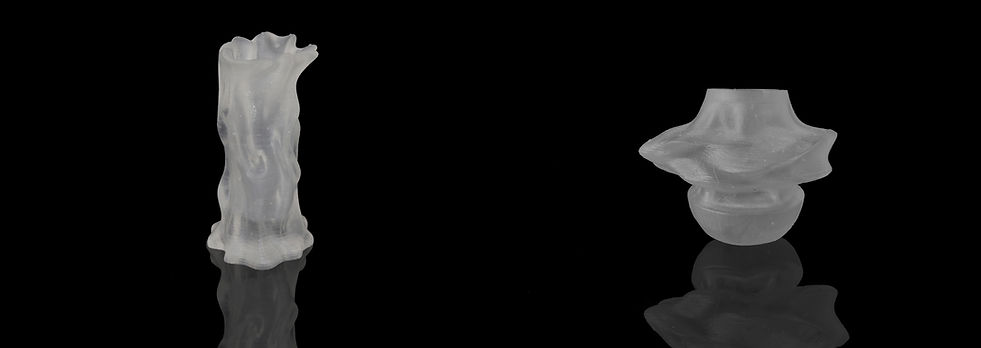DIGITAL CRAFTING in GLASS
2018
A ‘craft’ can be described as an interaction and connection between a person and a tool; be it a pen, a glass blower's pipe or a computer. New digital tools have bridged the gap between the digital and material world. The project explored the new relationship between traditional glass making techniques and the digital fabrication processes. It also looked at the impact of new technologies on crafts in the age of the post-digital artisan.

CONTEXT
The project focuses on a long period of handmade via new digital techniques. The project practiced three new crafting methods in glass which are:
- lost PLA casting
- merging the kiln cast digitally created pieces with hot blown glass, and
- laser cutting for sandcasting.
LOST PLA CASTING
During the creation of the glass pieces, I tried to capture dynamic shapes, such as water and wind.
The creation process (left page) was as follows:
1. Create the 3D model through Rhino (CAD software).
2. Do a 3D print of the model.
3. Make the mould, by binding the model with plaster.
4. Put the mould into the kiln to burnout the PLA model.
5. Make a reservoir to load the glass.
6. Load the glass in the mould and place it in the kiln.
7. Break the mould to take out the glass piece.
8. Do the coldwork, which will include sanding and polishing.







Making processes of losting PLA casting

Outcomes of losing PLA casting
MERGING CASTING WITH BLOWN GLASS
When using this method, one must take into consideration the relationship between the cage and the organic nature of hot glass.
The creation process is as follows:
1. Build a 3D model of the cage with Rhino.
2. Turn it into glass using the lost PLA casting method.
3. Place the glass in the kiln to heat up.
4. Blow the glass in the cage.
5. Place the work in the kiln to cool down.
6. Do the coldwork, which will include sanding and polishing



Making processes of merging casting with blown glass

Outcomes of merging casting with blown glass
LASER CUTTING FOR SANDCASTING
When use this method, the object must not have any undercuts and be able to be pulled out of the sand in one piece. The form needs to be simple due to the limitations of the process.
The creation process is as follows:
1. Design the laser cut shape with CAD software.
2. Laser cut the MDF boards and glue the pieces together and insert two nails on the back side
3. Prepare the wet sand
4. Push the model into sand
5. Pull the model out and leave the mould on the sand
6. Pour the hot glass into the mould on the sand
7. Heat up the glass in the sand with a torch gun
8. Dig out the glass out of the glass piece from the sand and move it into kiln
9. Let the glass piece cool down into the kiln



Making processes of laser cutting for sand casting

Outcomes of laser cutting for sand casting
